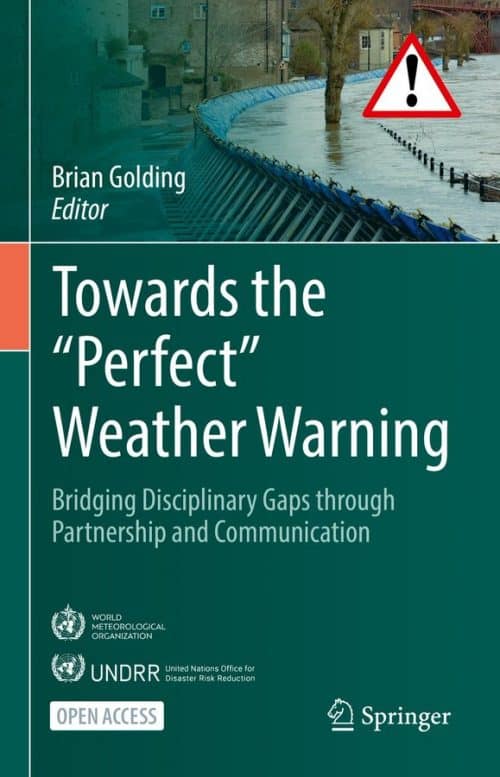Two researchers from the Resilience Challenge, David Johnston (co-lead of Urban) and Sally Potter (co-lead of Weather & Wildfire) were recently co-authors on a new open-access book, titled ‘Towards the “Perfect” Weather Warning’, edited by Brian Golding from the UK Met Office and published by Springer. The book discusses how to make weather warnings more effective through interorganisational communication and partnerships, from decision-making through the value chain to the meteorological observations. The book is aimed at anyone who creates or uses weather warnings, including government, private businesses, voluntary organisations, weather and hydrology services, and emergency managers.
The book is a product of the World Meteorological Organization’s (WMO) World Weather Research Programme (WWRP), through the High Impact Weather project. Both Sally and David have had key roles in this 10 year-project, with Sally the current co-lead with Brian Golding. Their work with the WMO is aligned with that of the Resilience Challenge.
Chapter 3 Summary:
Connecting Warning with Decision and Action: A Partnership of Communicators and Users

With an international team Sally Potter co-authored Chapter 3 – Connecting Warning with Decision and Action: A Partnership of Communicators and Users. This chapter explores what is needed to bridge the gap between those producing warning information and those that are needing to use it. It outlines how people respond to warnings in various ways as influenced by factors such as the sources of information, social and environmental cues, access to the channels the warning is issued through, and the receiver’s characteristics. The chapter highlights how the warning process is not only about exchanging information but also about establishing relationships. This requires knowledge about the receiver’s needs, beliefs, values, behaviours, and decision-making processes.
Warning messages should be tailored to different groups of receivers, and more research needs to be done in this space. The Common Alert Protocol can help with this whilst minimising the overheads of using multiple channels. Chapter 3 also describes how warning systems need to be critically evaluated to receive feedback on warning effectiveness and allow for two-way communication. Case studies are described for a user needs assessment for Argentina, increasing the value of warnings in the USA, probabilistic forecasts for emergency managers in Germany, and a community-based warning system in Nepal. Success of warnings is determined in partnership between the warner and receivers and requires interdisciplinary sciences to work together.
Chapter 4 Summary:
Connecting Forecast and Warning: A Partnership Between Communicators and Scientists

With an international team David Johnston co-authored Chapter 4 – Connecting Forecast and Warning: A Partnership Between Communicators and Scientists. This chapter examines the ways that warning providers connect and collaborate with knowledge sources to produce effective warnings. It first looks at the range of actors who produce warnings in the public and private sectors, the sources of information they draw on to comprehend the nature of the hazard, its impacts and the implications for those exposed, and the process of drawing that information together to produce a warning. The chapter further considers the wide range of experts who connect hazard data with impact data to create tools for assessing the impacts of predicted hazards on people, buildings, infrastructure and business. Finally, the chapter looks at the diverse ways in which these tools need to take account of the way their outputs will feed into warnings and of the nature of partnerships that can facilitate this. The chapter includes examples of impact prediction in sport, health impacts of wildfires in Australia, a framework for impact prediction in New Zealand, and communication of impacts through social media in the UK.




